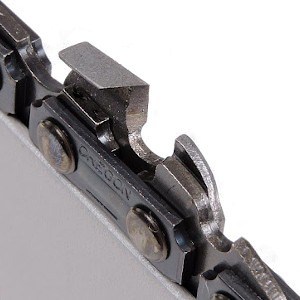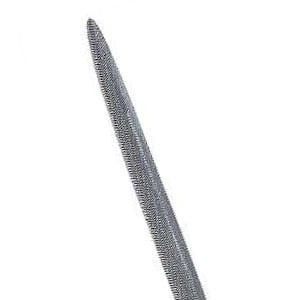 It is absolutely critical that your chainsaw has a well-maintained chain. The chain is what allows you to cut through wood, and after a lot of hours of use, the chain eventually becomes worn. Once the chain has become worn, you will have a much more difficult time cutting through wood. You will find yourself getting fatigued and having to use way more energy than should be necessary.
It is absolutely critical that your chainsaw has a well-maintained chain. The chain is what allows you to cut through wood, and after a lot of hours of use, the chain eventually becomes worn. Once the chain has become worn, you will have a much more difficult time cutting through wood. You will find yourself getting fatigued and having to use way more energy than should be necessary.
The way to fix this is to keep your chain working properly. If you don’t want to be tired, and you don’t want unnecessary strain being placed on your tool, it is imperative that you keep the chain sharp.
You can do this by using a chainsaw file. But you must use the correct chainsaw file size. If you use a file that is the wrong size, it can result in your chainsaw being improperly sharpened.
An improper chainsaw can create the wrong type of sawdust while cutting, which will inevitably clog the air filter inside the tool. Additionally, using the wrong file could actually make your chain duller, which will inevitably lead to more instances of violent kickback. This is a danger for you.
Luckily, today we are going to learn all about the proper chainsaw file size. Let’s take a closer look.
Types of Cutters
It takes a special file to sharpen a particular chain. Not all files will work on all chains. If you want the exact file that will sharpen your chainsaw, you must read the chainsaw manual that came with your machine, since it has the instructions for choosing the right file and the right gauge.
That being said, I understand you probably don’t have the manual anymore. I mean, come on… who keeps their chainsaw manual handy in the garage in a neatly indexed folder? It just doesn’t happen. So, if you don’t have the manual, you can get most of the information from this guide.
To understand why there are different chainsaw files, it is important to understand that there are different cutting teeth on different chains. These are known as cutters, but they are basically teeth. Each chainsaw comes with a certain type of cutter that is the actual piece that bites the wood.
There are three kinds of cutters. There is the chipper cutter, the chisel cutter, and the semi-chisel cutter.
 Round/Chipper Cutter
Round/Chipper Cutter
Chipper cutters are the most common. They are also the easiest to file. Chipper cutters tend to tolerate dust and dirt much better than the other two. They are very easy to sharpen by using a file and a guide. These are definitely the best cutters if you want a smooth cut with your wood. The chipper cutter is recognizable by its curved, slightly hooked end.
Semi-Chisel Cutter
This is the least aggressive type of color. It comes with a fairly dull point and can be sharpened easily with a round file and a guide. These types of cutters are not that common.
Chisel Cutter
Chisel cutters are super aggressive. These are used only by professional workers who understand commercial timber harvesting. You will probably never encounter one of these unless you become a lumberjack. This particular cutter requires a very special file that will fit inside the square shape of its cutting edge. There is no way to use a guide while sharpening the chisel cutter.
Read More: Chainsaw Chain Types – A Thorough Guide
Chainsaw File Sizes
 There are three main sizes for chainsaw files. You have the 4mm, the 4.8mm, and the 5.5mm. Each file comes either round or flat. There are really only two types of files you will ever use. It all depends on what type of cutter you have, like what I mentioned in the previous section.
There are three main sizes for chainsaw files. You have the 4mm, the 4.8mm, and the 5.5mm. Each file comes either round or flat. There are really only two types of files you will ever use. It all depends on what type of cutter you have, like what I mentioned in the previous section.
If you have a chipper cutter, which is the most common cutter found on basically every residential chainsaw sold in a hardware store, you are going to use a round file. If your cutter has a pitch of about 5.5mm, you will use the exact same round file, 5.5mm.
If your chain comes with a chisel cutter, you are going to use a flat-file. The same rule applies: if you have a pitch of 5.5mm, you will use a flat-file that is 5.5mm. The pitch will generally match the file.
The Gauge
Gauges are used to check the length of the cutter, the top plate angle, and to make sure you have the correct depth before you start filing. Each gauge comes in one of four sizes. You have the 0.43”, the 0.050”, the 0.058”, and the 0.063”. It is always recommended that you never file the depth gauge below 0.025”, as the depth gauge is going to determine exactly how deep the chain will cut through wood.
The most common gauge you will find is 0.050”. If you file any lower than this, it is going to really kill the life of your chainsaw chain. You also want to file the depth gauge evenly throughout the entire gauge. If this is not done properly, your chain is going to vibrate, it won’t cut smoothly anymore, and it will probably cut crooked.
You can always find the measurement of the gauge displayed on the guide bar of the chainsaw itself. It will usually tell you in writing, near the other specs of the chainsaw. However, if you can’t find the markings or if the bar is too caked with mud, you can always use a pair of calipers to measure the gauge.
Chainsaw File Sizes: Final Thoughts
Always remember to stop cutting if your chain is really broken. Sharpening the blade with a file and guide can only work so many times. Considering how affordable chains are, I always suggest you simply buy a new one if your old chain is in truly rough shape.
If you are not entirely sure how to file your chain properly, and if everything explained in this guide sounds like a foreign language to you, I would suggest going to your nearest hardware store and asking for a hand.
Alternatively, you could always ask your neighbor. Never sharpen your chainsaw if you don’t understand the concept, as you will undoubtedly make it worse.

